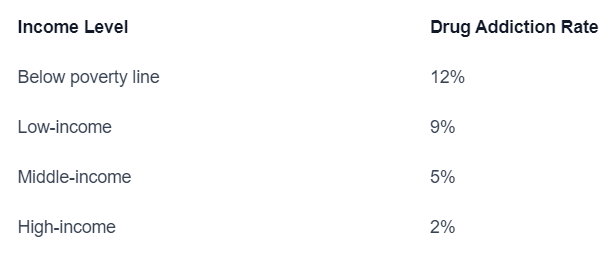Drug Addiction: A Complex Issue
Drug addiction is a multifaceted problem that is influenced by various factors, including socioeconomic status. Understanding the socioeconomic factors associated with drug addiction is crucial for developing effective prevention and treatment strategies. In this section, we will explore the connection between socioeconomic factors and drug addiction.
Understanding the Socioeconomic Factors
Socioeconomic factors refer to the economic and social conditions that shape an individual's life, including their income, education level, employment status, and access to resources. These factors can significantly impact a person's vulnerability to drug addiction.
Research suggests that individuals from lower socioeconomic backgrounds are more likely to experience higher rates of drug addiction. Factors such as poverty, limited educational opportunities, and lack of access to quality healthcare can contribute to this disparity. The relationship between drug addiction and poverty has been extensively studied, highlighting the impact of socioeconomic factors on addiction risk.
The Interplay between Socioeconomic Status and Drug Addiction
While drug addiction is often associated with poverty, it is important to recognize that drug addiction can also affect individuals from higher socioeconomic backgrounds. In recent years, there has been a growing concern over drug abuse among the wealthy. The pressures and lifestyle associated with affluence can contribute to substance abuse issues in this population.
The interplay between socioeconomic status and drug addiction is complex. While poverty can increase the risk of drug addiction due to limited resources and social disadvantages, wealth can be a risk factor as well, driven by unique challenges associated with affluence. Understanding these dynamics is crucial in developing targeted interventions and tailored treatment approaches for different socioeconomic groups.
By examining the relationship between socioeconomic factors and drug addiction, we can gain a better understanding of the underlying complexities of this issue. It is essential to address the unique challenges faced by individuals from different socioeconomic backgrounds when designing prevention and treatment programs. Taking a comprehensive approach that considers the social determinants of drug addiction can help break the cycle and improve outcomes for individuals struggling with substance abuse.
Drug Addiction Patterns: Rich vs. Poor
When examining drug addiction patterns, it is essential to consider the disparities that exist between different socioeconomic groups. Drug addiction affects individuals from all walks of life, but the trends and factors influencing drug addiction can vary significantly between the rich and the poor.
Trends in Drug Addiction among the Rich
Contrary to popular belief, drug addiction is not limited to low-income individuals. In fact, drug addiction can be found among individuals from high-income backgrounds as well. The patterns of drug addiction among the rich may differ in terms of substances abused and access to resources.
While the overall rates of drug addiction may be lower among the rich, there are specific substances that tend to be more prevalent in this group. For instance, the abuse of prescription medications, such as opioids and stimulants, is more commonly observed among individuals with higher socioeconomic status. This can be attributed to factors such as higher availability, easy access to healthcare providers, and the ability to afford expensive prescription drugs.
Trends in Drug Addiction among the Poor
On the other hand, drug addiction rates are often higher among individuals from lower socioeconomic backgrounds. Poverty can contribute to a range of social and economic factors that increase the risk of drug addiction. Limited access to education, stable employment, healthcare resources, and supportive social networks can create an environment conducive to substance abuse.
While drug addiction affects individuals from all income levels, certain substances are more prevalent among the poor. Drugs such as heroin, methamphetamine, and crack cocaine are often associated with lower socioeconomic groups due to factors such as affordability, availability, and the need for escape from challenging life circumstances.
Understanding the divergent drug addiction patterns between the rich and the poor is crucial for developing effective prevention and treatment strategies. It is important to recognize that socioeconomic factors play a significant role in shaping the drug addiction landscape, and addressing these factors is vital for comprehensive solutions.
By acknowledging the unique challenges faced by both the rich and the poor in relation to drug addiction, we can work towards implementing targeted interventions and support systems that address the specific needs of each group.
Socioeconomic Factors and Drug Addiction
The issue of drug addiction is complex and multifaceted, influenced by various socioeconomic factors. Understanding these factors is crucial to comprehending the patterns and prevalence of drug addiction. Two important aspects to consider are access to resources and treatment and the social determinants of drug addiction.
Access to Resources and Treatment
One of the key socioeconomic factors influencing drug addiction is the differential access to resources and treatment based on socioeconomic status. Individuals from lower socioeconomic backgrounds often face barriers in accessing healthcare services, including addiction treatment. Limited access to affordable and quality treatment facilities, as well as a lack of health insurance coverage, can hinder their ability to seek help.
On the other hand, individuals from higher socioeconomic backgrounds may have greater financial resources and access to comprehensive healthcare coverage. This can enable them to access a wider range of treatment options, including private rehabilitation centers and specialized programs. However, it is important to note that financial resources alone do not guarantee successful recovery or prevention of addiction.
To address this disparity, it is crucial to develop and promote initiatives that increase the availability and accessibility of resources and treatment for individuals from all socioeconomic backgrounds. This can include expanding public funding for addiction treatment programs, improving insurance coverage for addiction services, and implementing community-based support systems. By ensuring equal access to resources and treatment, we can reduce the socioeconomic barriers that contribute to drug addiction.
Social Determinants of Drug Addiction
Drug addiction is influenced by various social determinants that are interconnected with socioeconomic factors. These determinants include factors such as education, employment, family dynamics, and community characteristics. Individuals from disadvantaged socioeconomic backgrounds may face a higher prevalence of social determinants that contribute to drug addiction.
For example, limited educational opportunities and lower levels of educational attainment can increase the risk of drug addiction. Unemployment or unstable employment can also contribute to stress, anxiety, and a higher likelihood of substance abuse. Additionally, adverse family environments, such as a history of substance abuse within the family, can increase the vulnerability to drug addiction.
Addressing the social determinants of drug addiction requires a comprehensive approach. It involves implementing policies and programs that address educational disparities, promote stable employment opportunities, and provide support for families and communities affected by drug addiction. By tackling these underlying social determinants, we can create a more supportive and nurturing environment that reduces the risk of drug addiction.
Understanding the influence of socioeconomic factors and social determinants on drug addiction is vital for developing effective prevention and treatment strategies. By working towards equal access to resources and treatment and addressing the social determinants of drug addiction, we can strive towards a society where individuals from all socioeconomic backgrounds have the opportunity to lead healthy and drug-free lives.
Breaking the Cycle
Addressing Socioeconomic Disparities
To effectively address drug addiction, it is crucial to tackle the underlying socioeconomic disparities that contribute to its prevalence. Socioeconomic factors, such as income, education, and access to resources, play a significant role in shaping drug addiction patterns. By addressing these disparities, society can take a proactive approach towards preventing and treating drug addiction.
One of the key aspects of addressing socioeconomic disparities is ensuring equal access to resources and treatment for all individuals. Unfortunately, individuals from lower socioeconomic backgrounds often face barriers in accessing quality healthcare, including addiction treatment. By implementing policies and programs that prioritize affordability, availability, and accessibility of addiction treatment services, we can bridge the gap and provide equal opportunities for recovery. Additionally, it is essential to promote education and awareness about drug addiction in underserved communities, empowering individuals with knowledge and resources to seek help.
Importance of Holistic Approaches to Drug Addiction Treatment
When it comes to drug addiction treatment, taking a holistic approach is paramount. Holistic treatment focuses on addressing the physical, psychological, and social aspects of addiction, recognizing that drug dependency is a complex issue that requires comprehensive care. This approach goes beyond solely addressing the symptoms of addiction and delves into the underlying factors that contribute to substance abuse.
Holistic treatment programs often incorporate a variety of therapeutic techniques, including counseling, behavioral therapies, support groups, and alternative therapies like yoga or mindfulness. By considering the individual's unique circumstances, including their socioeconomic background, holistic approaches aim to provide personalized care that addresses the root causes of addiction. This comprehensive treatment approach helps individuals develop coping mechanisms, improve their overall well-being, and reduce the risk of relapse.
By adopting a holistic approach to drug addiction treatment, we can better address the specific needs of individuals from different socioeconomic backgrounds. It allows us to tailor interventions and support systems to overcome the challenges faced by individuals with limited resources or living in disadvantaged communities.
By addressing socioeconomic disparities and implementing holistic approaches to drug addiction treatment, we can break the cycle of addiction and promote healthier, more inclusive communities. Through a combination of equitable access to resources and comprehensive care, we can work towards a society where socioeconomic factors no longer serve as barriers to recovery.
Drug Addiction Patterns: Rich vs. Poor
When examining drug addiction patterns, it is important to consider the diverging trends between the rich and the poor. Socioeconomic factors play a significant role in shaping drug addiction rates and behaviors within these distinct groups.
Trends in Drug Addiction among the Rich
Contrary to common assumptions, drug addiction is not limited to any particular socioeconomic group. The wealthy, too, face their own set of challenges when it comes to drug addiction. The availability of disposable income and access to a wide range of substances can contribute to drug abuse among the affluent. However, it is crucial to note that the patterns and types of substances used may differ from those prevalent among the economically disadvantaged.
Table: Prevalence of Drug Abuse among the Wealthy

Trends in Drug Addiction among the Poor
Drug addiction rates are often higher among individuals from lower socioeconomic backgrounds. Several factors contribute to this disparity, including limited access to resources, higher exposure to stressors, and a lack of social support systems. Poverty can create a challenging environment that increases the likelihood of substance abuse and addiction.
Table: Drug Addiction Rates by Income

Understanding the varying drug addiction patterns between the rich and the poor is crucial in developing effective prevention and treatment strategies. It is important to consider the specific challenges and circumstances faced by each group when addressing drug addiction within these populations. By acknowledging and addressing the socioeconomic factors that contribute to drug addiction, we can work towards creating a more inclusive and comprehensive approach to addiction treatment and prevention.
Conclusion
Drug addiction is a complex issue that is influenced by a range of socioeconomic factors. By examining the patterns and prevalence of drug addiction among different socioeconomic groups, we can gain a better understanding of the underlying complexities of this issue. It is essential to address the unique challenges faced by individuals from different socioeconomic backgrounds when designing prevention and treatment programs. Taking a comprehensive approach that considers the social determinants of drug addiction can help break the cycle and improve outcomes for individuals struggling with substance abuse.
In conclusion, addressing the socioeconomic barriers to drug addiction prevention and treatment is crucial for creating healthier communities. By promoting equitable access to resources and implementing holistic approaches to care, we can work towards breaking the cycle of addiction.
Understanding and addressing the unique challenges faced by individuals from different socioeconomic backgrounds is key to developing targeted interventions and support systems that meet their specific needs. Through collaborative efforts across all sectors, we can strive towards a society where drug addiction is no longer a barrier to individual well-being and community prosperity.

.svg)
.svg)


